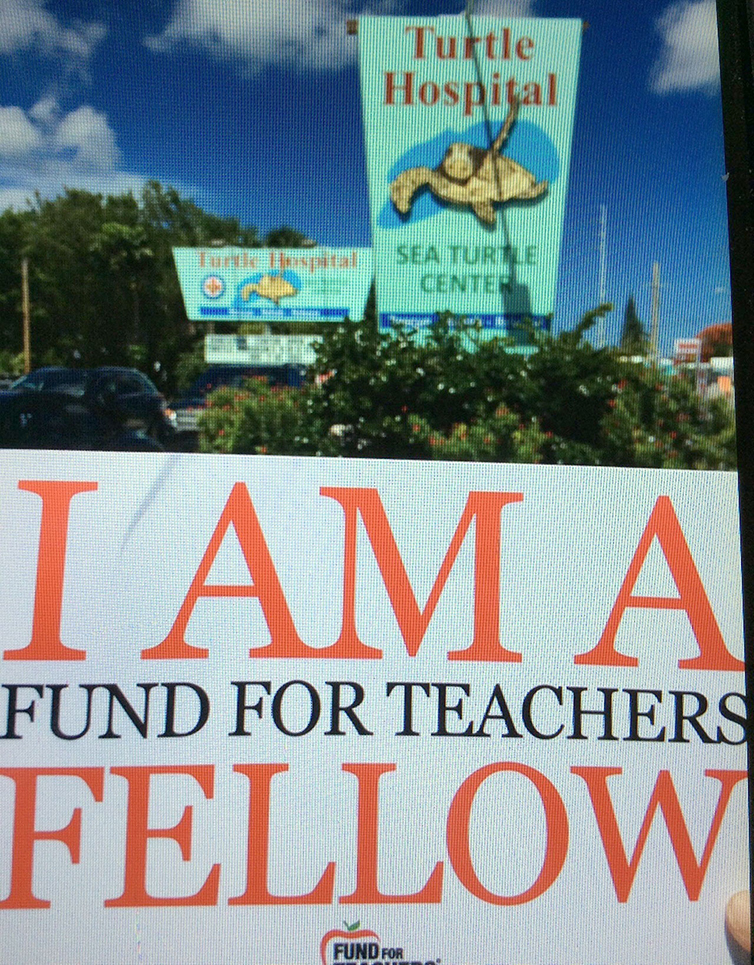Habitat and Rehabilitation

Thanks to Suzanne Almon for this account of how her fellowship in the Florida Keys and Hurricane Irma are engaging students at Asian Studies Academy in Hartford, CT. Suzanne used her FFT grant to research the life cycle, habitat and rehabilitation of sea turtles in Florida and the Galapagos Islands to design a first grade, project based learning science unit on animal habitats.

One of Suzanne’s students reading Gail Gibbons’ “Sea Turtles.”
As a first grade teacher in an urban school, I strive to bring learning to life by bringing into the classroom artifacts, books, posters, magazines, pictures and videos. I was so excited to apply for the Fund for Teachers grant, because I knew it would be a great opportunity to bring in another element to enhance my teaching – making me the primary source! Deciding on what to pursue was simple; I knew instantly I wanted to study sea turtles. I designed my fellowship with a new Sea Turtle unit in mind, a component of our science curriculum that would cover anatomy, natural environment, natural and unnatural issues facing sea turtle survival and rehabilitation. My inspiration during the proposal phase was Gail Gibbons’ book Sea Turtles, a non-fiction book about sea turtles, that includes ways to help keep sea turtles safe.
All around the Keys, there is an awareness to conserve native animals; Key Deer crossing signs, alligator crossing signs, clean up your garbage and no balloons at the beach signs, etc. I was fortunate to witness first hand how sea turtles are nursed back to health through a visit to the Turtle Hospital in Marathon, Florida. The Turtle Hospital is a safe haven for injured and sick sea turtles and also has a museum in their front lobby full of information. The guide introduced me to the different sea turtles that make Florida their home and to the hospital’s marine residents. The hospital has cared for and released more than 1500 sea turtles since its beginning in 1986.
I was also able to do research on Juno Beach, one of the most active sea turtle nesting beaches in the world. I witnessed loggerhead sea turtles coming to shore and laying eggs. It was an amazing experience! These sea turtles are massive and lay about hundred ping-pong sized eggs while in a trance. The Loggerhead Marine Center’s volunteers invited me to observe this life experience and provided an immense amount of information about their Marine Center, Loggerheads, and the beach.
I returned home from my fellowship on August 22 and ten days prior to Hurricane Irma. In preparation for the storm, The Turtle Hospital moved all “patients” to special hurricane tanks to protect from winds and storm surge. All of the Loggerhead Marine Center’s sea turtles were transported to the Georgia Aquarium. Unfortunately, the nests were not so fortunate. It is reported that due to the heavy storms and increased wave action, the sea turtle nests were wiped out, exposing eggs. The Center informed supporters that they would continue to take in injured sea turtles and hatchlings. Since Hurricane Irma, they have re-opened and have received about 200 hatchlings!
Hurricane Irma hit Florida shortly after school started. My heart was full of dread and anticipation; hoping the hurricane would turn east. Entire oceanside roads were wiped out, trailers and boats were flipped, severe flooding and high winds knocked down palm trees and hurled debris everywhere. Eight people died from natural causes and the storm and another 40 have been injured (30 are from Key West) at the time of this writing. Businesses and homes have been destroyed, as well as the beaches. I love the Florida Keys and I know with time, hard work, and love, the Keys will be rejuvenated and better than ever.
When school started, shortly after Irma’s devastating arrival, students from last year streamed into my class, excited to see me and my photos and hear about my sea turtle learning! They and my new students could not believe that I saw sea turtles and even swam with them! They were so excited to see my videos and especially enjoyed seeing me feeding the sea turtles at the Turtle Hospital and watching them snort water out their noses.
As of today, the building remains closed due to substantial amount of damage in Marathon and the Florida Keys; however, our sea turtle unit is in full swing. Students are watching my interviews with marine biology professionals, as well as my snorkeling in the marine reserves. They are developing writing skills and integrating art into their own non-fiction texts about sea turtles, similar to Gail Gibbons’ exemplar; eventually, they will turn the texts into presentations for their peers at a school assembly.
Lastly, we are scheduling a field trip to our own beach habitat. In conjunction with the Connecticut Department of Energy and Environmental Protection (CT DEEP), students will replicate the experiential learning on my fellowship to learn how they can help sea turtles in Connecticut.

[minti_divider style=”1″ icon=”” margin=”30px 0px 30px 0px”]
In addition to the Florida Keys, Suzanne also researched sea turtles in Myrtle Beach, GA, and the Galapagos Islands on her fellowship. Suzanne started teaching preschool 2001 and has taught in Hartford for 11 years and was recognized as Teacher of the Year in 2011. Shestrives to build competent and confident learners to be successful and have positive influences in the world.
 Back to Blogs
Back to Blogs